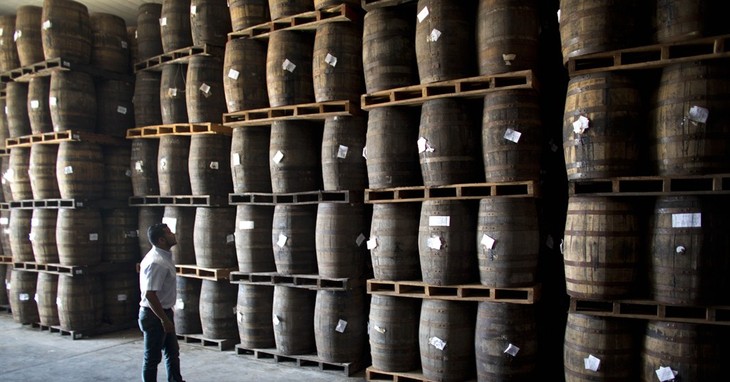A willingness to explore rum options will lead to exotic enjoyment.
Among the liquors consumed in this country, rum takes on a curious position, in that it can be regarded equally as a mixer or as a quality product on its own. While sales of vodka top all the distilled spirits in the U.S., it is thought of primarily as an ingredient. Even in regards to the high-end labels Grey Goose or Chopin, for example, few sip these as a straight product; they are the base component to a preferred cocktail. Rum, meanwhile, enjoys a breadth of versatility, and this is due in part to the fact there are varieties of the spirit beyond merely adding flavorings.
There is a whole color range to find — from white (clear) to blonde, golden, amber, and dark — and that just covers the styles. There are all manner of vintages and aging methods to explore, as well. This wide selection allows for far more complex cocktail creations. Then, once you are willing to expand into the sipping quality rums, the flavors you can find will be deeply enjoyable and can compete with the experience found with high-quality bourbons and scotches. Once you tie in the direct connectivity to the tiki bar lifestyle, rum has now become more than an ingredient, it has taken on a complete personality.
Adding to this mystique is the fact that this spirit is firmly embedded in the culture of the Caribbean, for reasons both obvious and subtle. Take one reality of the drinking traditions from down-island; while there are select few beer labels to be regarded from this region there is a wide array of these elixirs that are considered specific to the nations. Jamaican rum is widely known, Cuba has a revered distilling tradition, and on Puerto Rico it is considered an island stable. Peruse the shelves at a large liquor retailer and you are sure to find high-grade offerings from Barbados as well as Dominican, Costa Rican, and Panamanian offerings which can be impressive.
The reason behind this diversity among the island nations has everything to do with the product upon which rum is created. While the limited landmasses on most of the countries encircling the Caribbean sea prevent the large harvests of grains needed to make beers or whiskey, the base ingredient of rum is both readily produced and has something of a middle-man avoidance. To get alcohol for most spirits, it involves promoting the natural processing of starches into a product to be consumed by yeast.
For the islanders, there was something of a shortcut available; no need to rely on germination to produce sugars for the bio-conversion, when you can begin with the base product created naturally from an easily grown crop.

The Botany Of The Tropics
The earliest known instances of sugarcane cultivation go back thousands of years, generally regarded to be in New Guinea. The plant is a hardy cultivar and is a grass that travels well. The segmented stalks feature small nobs at each joint and when planted these sprout initial roots and a new stalk will grow. Considering the Caribbean is situated at about the same distance from the equator once brought to the new world, this heat-resistant crop flourished.
The cane stalks are dense and fibrous, and this is because the internal construction serves as a two-way delivery system. Water is easily drawn up, and sugars produced by the leaves are sent downward, concentrating in the base of the stalks to produce growth and to get ready for flowering, so harvesting takes place just prior to this happening. The stalks are cut to a pulp used to extract a syrupy, rich fluid. This is processed with heat to generate crystallization and create the base product sugar.
A number of regional spirits can be made with this base syrup, but what remains after the crystals are taken is molasses, and this becomes the basis of rum. Mixed with water and yeast, fermentation takes place. In the early days rum was considered little more than a byproduct and was made to give to the slave workers. The arrival of the colonists to early America created a demand for an easily fermentable product. Molasses was sent to the colonies; for a time, New Guinea was the biggest rum producer in the hemisphere. One of the biggest financial battles with the British crown was the heavy tariffs placed on molasses produced on the French-controlled islands.

Rum soon became a central product in the colonies and the sea-faring realms. The British navy gives us one enduring item in the measuring of alcohol. Sailors were allocated a daily ration of rum, to keep up morale and fight off scurvy. Their allotment was in the form of rum, water, sugar, and lime juice — the earliest daquiri. The sailors eventually demanded that it be assured that they were receiving an undiluted serving of their preferred spirit, and a tactic was hit upon. The rum was mixed with a measure of gunpowder and if it was the proper strength, it would ignite, while a diluted rum would not. This was conducted by a ship’s officer, to offer “proof” of the alcohol content.
It was not until early in the 20th century when rum would become transformed, if not in content, at least in perception. That was when the growing affection for Polynesia in our entertainment blossomed into Tiki Culture. With the emergence of Don The Beachcomber and Trader Vic’s, soon this became a national trend, and at the heart of it was the complex potables concocted to evoke the exotica and escapism of faraway lands. Rum was transformed from a base ingredient into a vital centerpiece.
Broaden Your Hemisphere
To get a sense of the difference between quality rum and the base products on your next night out begin with a classic — the Rum & Cola. Start with whatever well rum they have, then for your second, see what they have for upper-level offerings. The difference will be apparent, and hopefully, send you on a course of exploration.
When looking over the rum aisle, you will be inundated with a wide variety of the basics, but if you are intrepid enough to venture beyond the Bacardis and Cruzan flavor options, there are some deeply satisfying aged options to be savored.
If you need a port of entry, there is a flavored dark rum that is recommended. Rather than a diluted white with artificial flavorings, seek out Plantation Stiggins’ Fancy Pineapple. This is a complex rum as a base and local pineapples are infused into the mixture, all while preserving the 80 proof character. Great as a cocktail base or enjoyed straight.

For true sipping pleasure, there is an Ernest Hemingway-inspired brand called Pilar (named after the writer’s beloved fishing vessel). Blended in Key West from a variety of Caribbean islands, as well as Florida, their products are well recommended. The top pick is possibly their dark sherry, cask-aged version, which manages to deliver a variety of flavors. You’ll smell caramel in the glass and then sample tastes between woods, brown sugar, and softer spices. This demands you pay attention while sipping.

Another readily available option would be Bumbu XO. The brand was touted with a launch featuring rapper L’il Wayne, but this new version is something different. A purely Panamanian product, it is aged for 18 years in bourbon barrels, then a second aging takes place in oak casks. The character here is deep, and it evolves over a long drink, as well as holding up well with a cigar.
If looking for a more casual or festive time with this island spirit, then some rum-based cocktails are in order. Make room on the bar shelf for some bottles to give you flexibility and options.
THE RUMRUNNER
This island classic lives up to its name, featuring multiple rums, numerous flavors, and it packs a punch that is delicious at the same time.
- 2 oz. Orange Juice
- 2 oz. Pineapple Juice
- 3/4 oz. Banana Liqueur
- 3/4 oz. Blackberry Liqueur
- 1.5 oz. White Rum
- 1.5 oz. Dark Rum
- 1 Tsp. Grenadine
- 3/4 oz. 151 Rum
In a shaker combine the first six ingredients with ice and shake well. Pour into Hurricane glass, drizzle grenadine, float the 151 Rum on top. Garnish with orange wheel
BAHAMA MAMA
Another multi-rum, multi-fruit mixture that goes down almost too easily.
- 2 oz. Orange Juice
- 2 oz. Pineapple Juice
- 1.5 oz. White Rum
- 1.5 oz. Coconut Rum
- 3/4 oz. Dark Rum
- 1 Tsp. Grenadine
In a shaker mix the juices and rums with ice. Shake well, and pour into Hurricane glass. Drizzle Grenadine. Garnish with coconut shavings and orange wheel.
SHARK ENCOUNTER
This is a visual treat that also has a great flavor. A fun, rum potable to make during Shark Week, or when hosting a “Sharknado” movie marathon party…if anyone still does such a thing.
- 1 oz. Simple Syrup
- 1.5 oz. White Rum
- 3/4 oz. Coconut Rum
- 3/4 oz. Blue Curacao
- 2 oz. Lemonade
- Grenadine
Mix ingredients in Collins glass. Drizzle Grenadine on the surface to replicate a blood slick. Garnish with a gummy shark.
CARIBBEAN RUM PUNCH
This is an island classic (allowing for interpretations) that is based on proportions, rather than measurements. So goes the recipe, “1 Part sour/2 Parts sweet/3 Parts strong/4 Parts weak” The mix can be small, with ounces measured for a single drink, or can be made in a batch, using fluid cups for a pitcher. Larger mixtures can use multiple rums.
- 1 oz./cup Lime Juice
- 2 oz./cups Simple Syrup
- 3 oz./cups Rum (choice)
- 4 oz./cups Juices (choice)
- 4-6 dashes Orange Bitters (based on size of mixture)
Garnish with Orange wheel and Cherry.
SHRUNKEN SKULL
This rum bomb was inspired by offerings at the tiki mecca in Fort Lauderdale, The Mai Kai restaurant. A tiki mug is the preferred vessel, of course.
- 1 oz. White Rum
- 1 oz. Dark Rum
- 1 oz. Coconut Rum
- 1 oz. 151 Rum
- 2 oz. Pineapple Juice
- 2 oz. Pomegranate Juice
With ice in a shaker mix the juices with the first 3 rums. Shake and pour in the mug, then float the 151 shot on top. Optional choice: ignite the rum















